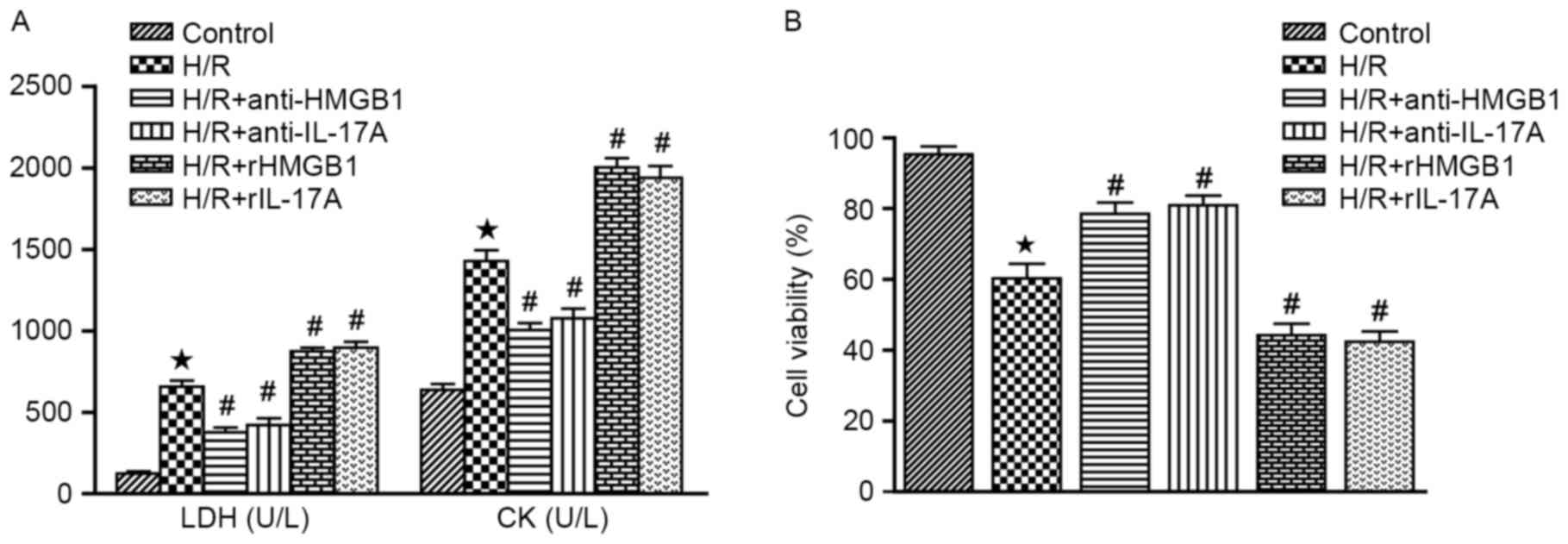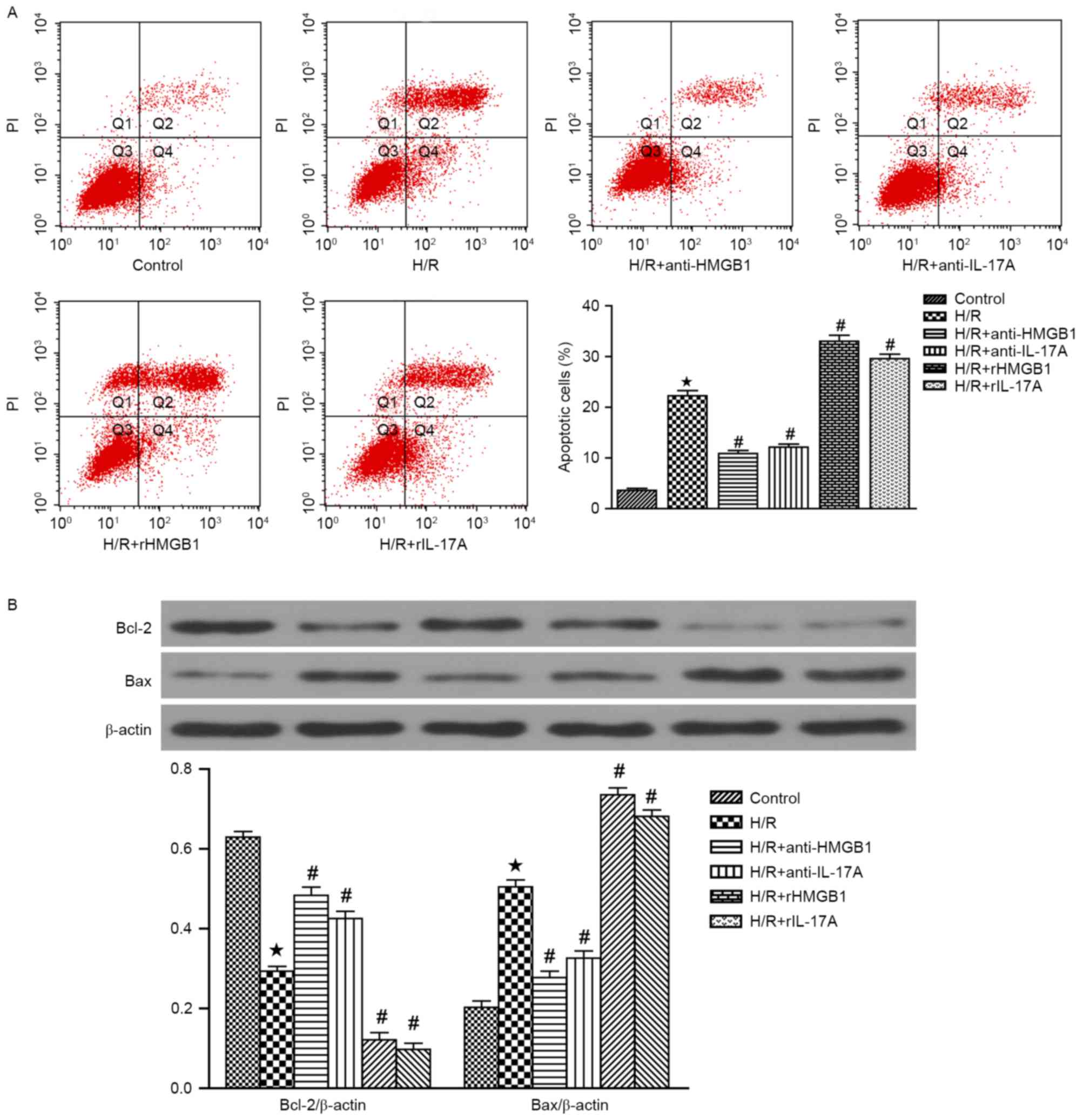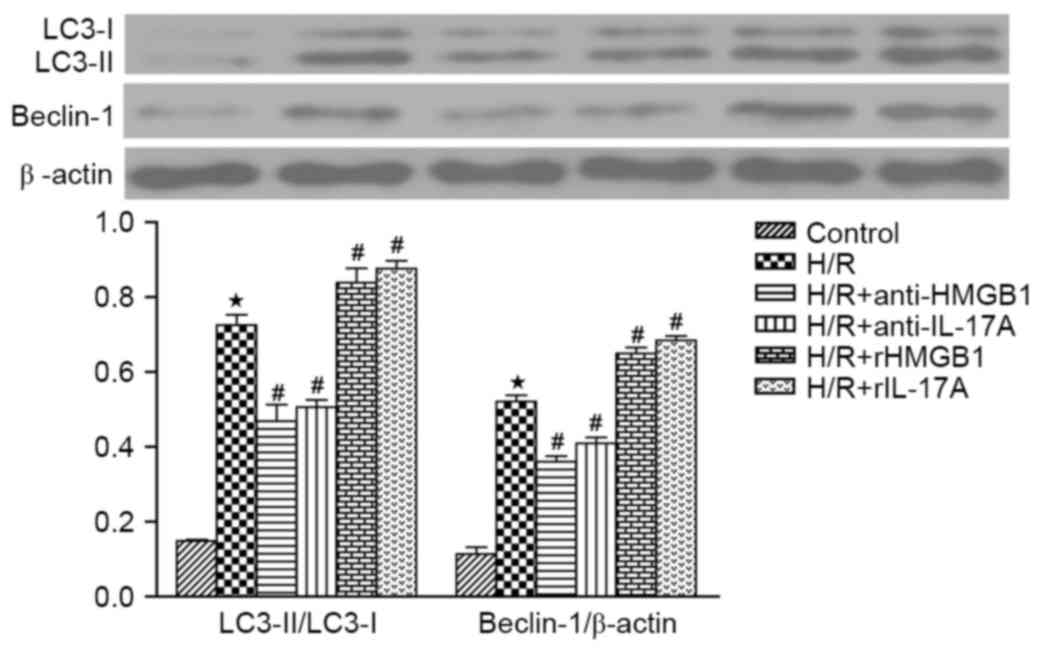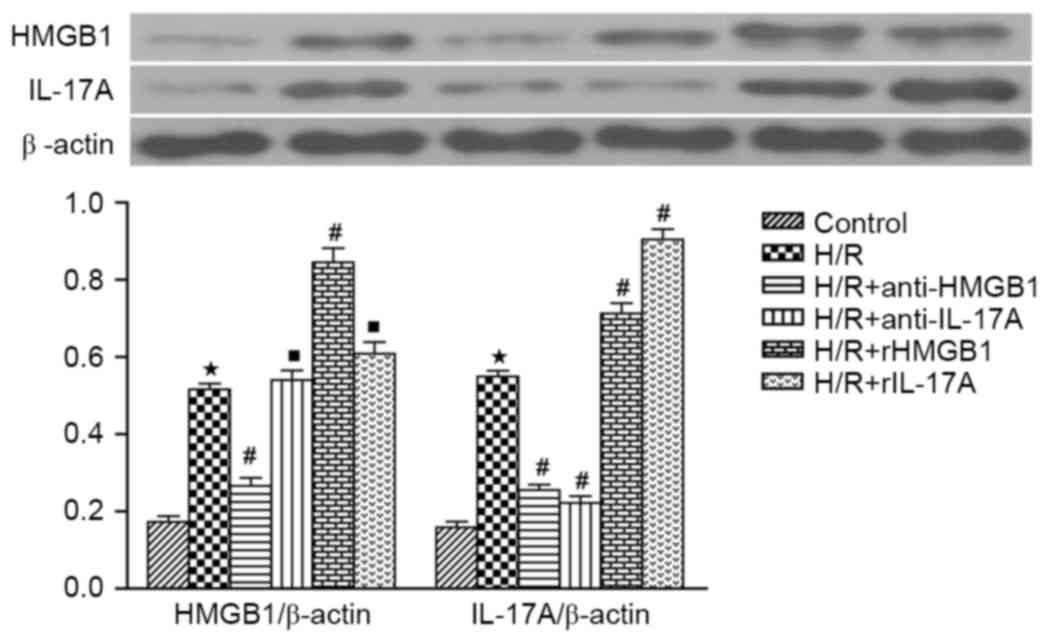The HMGB1‑IL‑17A axis contributes to hypoxia/reoxygenation injury via regulation of cardiomyocyte apoptosis and autophagy
- Authors:
- Published online on: October 20, 2017 https://doi.org/10.3892/mmr.2017.7839
- Pages: 336-341
Abstract
Introduction
Myocardial ischemia/reperfusion (I/R) injury is a complex pathophysiological process, including an inflammatory response, apoptotic cell death and autophagy, which may result in myocardial cell damage (1–3). Therefore, prevention and treatment of myocardial I/R injury has become one of the most important tasks for patients with ischemic heart disease.
The interleukin (IL)-17 cytokine family consists of six members (IL-17A-F). IL-17A and IL-17F share the greatest similarity, with 55% homology at the amino acid level. IL-17A is a member of the IL-17 cytokine family, secreted by CD4+αβ T cells, rδT cells, natural killer cells and neutrophils (4). In myocardial I/R injury, it has been indicated that IL-17A is produced primarily by rδT cells and plays a pathogenic role by inducing cardiomyocyte apoptosis and neutrophil infiltration (5). These indicated that IL-17A serves a critical role in myocardial I/R injury.
High-mobility group box 1 protein (HMGB1), a highly conserved nuclear protein that is released from necrotic cells and secreted by activated macrophages, natural killer cells and mature dendritic cells, can function as an extracellular signaling molecule during inflammation, cell differentiation, cell migration and tumor metastasis (6). Andrassy et al (7) demonstrated that the expression of HMGB1 was significantly increased during the reperfusion period and could exaggerate myocardial I/R injury, while inhibiting HMGB1 could reduce myocardial I/R injury. A recent study indicated that HMGB1 could aggravate the cerebral I/R injury by upregulating the expression of IL-17A, as well as increasing neuronal apoptosis (8). In addition, a previous study of the authors reported that HMGB1-IL-17A axis serves an important role in the pathogenesis of myocardial I/R injury (9). However, whether the HMGB1-IL-17A axis is involved in regulating cardiomyocyte apoptosis and autophagy in myocardial I/R injury remains unclear. The current study, therefore, aims to investigate the HMGB1-IL-17A axis in a cardiomyocyte hypoxia/reoxygenation (H/R) injury model to elucidate its possible role in regulating cardiomyocyte apoptosis and autophagy in myocardial I/R injury.
Materials and methods
Cell culture and experimental design
The cell extraction protocol for cardiomyocyte primary culture was approved by the Institutional Animal Care and Use Committee of Wuhan University (Wuhan, China). A total of 100 Sprague-Dawley rats (1-3-day-old) were purchased from the Centre of Experimental Animals at Wuhan University (Wuhan, China). Primary cultures of neonatal rat cardiomyocytes were prepared from the ventricles of rats. Briefly, the hearts were harvested and finely minced with scissors for about 1 min and then dissociated with 0.125% (w/v) trypsin and 0.08% collagenase I for five times at 37°C. The collected enzyme solution is next centrifuged (170 × g, 4 min, 4°C), the supernatant discarded, and cells re-suspended in Dulbecco's modified Eagle's medium (DMEM, Sigma-Aldrich; Merck KGaA, Darmstadt, Germany) containing 15% (v/v) fetal bovine serum (FBS), 1% penicillin (100 U/ml) and 1% streptomycin (100 µg/ml). To reduce fibroblast contamination, cells were incubated at 37°C and 5% CO2 for 1 h, then non-adherent cells (cardiomyocytes) in DMEM were collected and seeded in six-well plates at a density of 1×106 cells/ml. Cardiomyocytes were incubated for 4 days prior to conducting the experiment, then the cells were randomly assigned into six groups. The group descriptions are as follows: Control group (Control), cardiomyocytes were incubated in DMEM F12 with 15% FBS; Hypoxia and reoxygenation (H/R) group, cardiomyocytes were incubated in DMEM following 24 h of synchronization, subjected to hypoxia for 1 h at 37°C and 95% N2 at 5% (v/v) CO2 prior to incubation in DMEM F12 for 4 h; H/R+anti-HMGB1 group, cardiomyocytes were pretreated with HMGB1-neutralizing antibody (1:100 dilution; #BM3965; Wuhan Boster Bioengineering Co, Ltd., Wuhan, China) at 37°C for 24 h before incubation in DMEM, and then were subjected to H/R, as described above; H/R+anti-IL-17A group, cardiomyocytes were pretreated with IL-17A-neutralizing antibody (1:100 dilution; #A00421; Wuhan Boster Bioengineering Co, Ltd.) at 37°C for 24 h before incubation in DMEM, and then were subjected to H/R, as described above; H/R+rHMGB1 group, cardiomyocytes were pretreated with recombinant HMGB1 (rHMGB1; 200 ng/ml) at 24 h before incubation in DMEM, and then were subjected to H/R, as described above; and the H/R+rIL-17A group, cardiomyocytes were pretreated with recombinant IL-17A (rIL-17A; 100 ng/ml) at 24 h before incubation in DMEM, and then were subjected to H/R, as described above.
Assessment of cell injury
The extent of cell injury was assessed by the concentrations of lactate dehydrogenase (LDH) and creatine kinase (CK) in the culture medium. The protocols were followed according to the manufacturer's instructions (Nanjing Jiancheng Bioengineering Institute, Nanjing, China).
Assay of cell viability
Cell viability was determined using the Cell Counting Kit (CCK)-8 assay (Dojindo Molecular Technologies, Inc., Kumamoto, Japan), and the experimental procedure was based on the manufacturer's recommendations. Cardiomyocytes were seeded in 96-well plates at 1×105 cells/well and incubated for 4 d prior to treatments as described above. The absorbance of each well at 490 nm was measured with a microplate reader (Bio-Rad Laboratories, Hercules, CA). The percent cell viability was calculated using the following formula: % cell viability=(mean absorbance in test wells)/(mean absorbance in control wells) ×100.
Flow cytometry
Apoptosis rate was assessed by flow cytometric analysis of propidium iodide (PI) and Annexin V double staining. The cardiomyocytes were harvested after treatment, then rinsed in PBS and suspended in 500 µl binding buffer, and finally incubated with 5 µl Annexin V and 5 µl propidium iodide (Nanjing KeyGen Biotech. Inc., Nanjing, China). The stained cells were analyzed by using a BD flow cytometer (FACSCalibur; BD Biosciences, Franklin Lakes, NJ, USA).
Western blot analysis
The cultured primary cardiomyocytes were extracted to harbor protein solution in radioimmunoprecipitation assay lysis buffer (Beyotime Institute of Biotechnology, Nantong, China) after indicated experimental protocols. A BCA Protein Assay Kit (Wuhan Boster Biological Technology Co., Ltd.) was used to detect concentration of the proteins. Extracts containing 20 µg of protein were added into each well and subjected to 10% SDS-PAGE, which were then transferred onto polyvinylidene difluoride membranes (EMD Millipore, Billerica, MA, USA). Subsequently, the membranes were blocked by 5% BSA for 60 min at 37°C, paralleling the incubation of primary antibodies overnight at 4°C with anti-HMGB1 (1:1,000 dilution; #SAB2701809; Sigma-Aldrich; Merck KGaA), anti-IL-17A (1:800 dilution; #13838; Cell Signaling Technology, Inc., Danvers, MA, USA), anti- microtubule-associated proteins 1A/1B light chain 3B (LC3) (1:600 dilution; #SAB1306269; Sigma-Aldrich; Merck KGaA), anti-Beclin-1 (1:800 dilution; #3738; Cell Signaling Technology, Inc.), anti-Bcl-2 (1:800 dilution; #15071; Cell Signaling Technology, Inc.) and anti-Bcl-2-associated X protein (Bax) (1:600 dilution; #2774; Cell Signaling Technology, Inc.). After being washed in Tris buffered saline with Tween 20 for three times (10 min), the membranes were exposed to horseradish peroxidase-conjugated secondary antibody (mouse anti-rat IgG antibody; 1:1,000 dilution; #bs-0293M; Beijing Bioss Biological Technology Co., Ltd, Beijing, China) at 37°C for 2 h. The enhanced chemiluminescence reagent (Pierce; Thermo Fisher Scientific, Inc., Waltham, MA, USA) was used to visualize protein blots. The expression of protein was normalized to β-actin (mouse anti-β-actin antibody; 1:500 dilution; #bsm-33036M; Beijing Bioss Biological Technology Co., Ltd) expression. Image Lab software 3.0 (Bio-Rad Laboratories, Inc., Hercules, CA, USA) was adopted to measure the grey value of each band.
Statistical analysis
Statistical analysis was conducted with SPSS 18.0 software package (SPSS Inc., Chicago, IL, USA). All data are expressed as the mean ± standard deviation. One-way analysis of variance or the Welch test was used for comparisons among groups, and the Student-Newman-Keuls test or Dunnett's T3 test was used for post-hoc multiple comparisons. P<0.05 was considered to indicate a statistically significant difference.
Results
HMGB1 and IL-17A aggravate H/R-induced cell injury
As demonstrated in Fig. 1A, cardiomyocytes subjected to hypoxia and reoxygenation were able to cause the significant release of LDH and CK, when compared with the control group (P<0.05). Furthermore, rHMGB1 or rIL-17A increased the levels of LDH and CK, while HMGB1 or IL-17A antibody were able to suppress their release (all P<0.05 vs. H/R group).
HMGB1 and IL-17A inhibit the cell viability
The authors assessed cell viability with CCK-8 assays in each groups. The cell viability was markedly inhibited following H/R treatment, when compared with the control group (P<0.05). Interestingly, pretreatment with HMGB1 or IL-17A antibody significantly improved cell viability, while rHMGB1 or rIL-17A could inhibit the cell viability (all P<0.05 vs. H/R group). These findings indicated that HMGB1 or IL-17A could inhibit the cell viability in cardiomyocyte subjected to H/R (Fig. 1B).
HMGB1 and IL-17A aggravate H/R-induced cardiomyocyte apoptosis
Annexin-V FITC/PI staining was used to quantify the pro-apoptotic effects of HMGB1 and IL-17A. The apoptosis rate in H/R group was significantly increased (P<0.05 vs. Control). However, pretreatment with HMGB1 or IL-17A antibody could significantly attenuate the elevated H/R-induced cardiomyocyte apoptosis, while rHMGB1 or rIL-17A could aggravate the cardiomyocyte apoptosis (all P<0.05 vs. H/R group) (Fig. 2A). In addition, Bcl-2 (anti-apoptotic protein) and Bax (pro-apoptotic protein) expression were also measured by western blotting (Fig. 2B). A significant decrease in Bcl-2 expression and a increase in Bax expression were observed in H/R group, when compared with the control group (P<0.05). Meanwhile, HMGB1 or IL-17A antibody could increase the expression of Bcl-2 and decrease the expression of Bax (both P<0.05 vs. H/R group). In contrast, treatment with rHMGB1 or rIL-17A could attenuate the increased expression of Bcl-2 and decreased the expression of Bax (both P<0.05 vs. H/R group). These results strongly demonstrated that HMGB1 or IL-17A could aggravate H/R-induced cardiomyocyte apoptosis.
HMGB1 and IL-17A enhanced the expression levels of autophagy markers in cardiomyocytes subjected to H/R
It is well-understood that autophagy is regulated by autophagy-related proteins, such as, LC3-II/LC3-I and Beclin-1 (10). The ratio of LC3-II to LC3-I and the Beclin-1 expression were significantly increased in H/R group, when compared with the control group (P<0.05). The HMGB1 or IL-17A antibody could markedly decreased the ratio of LC3-II to LC3-I and the Beclin-1 expression when compared to H/R group, while those were even higher in H/R+rHMGB1 group or H/R+rIL-17A group (all P<0.05). It can be concluded that the autophagy was upregulated in cardiomyocytes exposed to H/R, and enhanced by HMGB1 or IL-17A prior to H/R (Fig. 3).
HMGB1 regulated the expression of IL-17A
According to the western blotting, both HMGB1 and IL-17A expression in H/R group were markedly increased compared to those in control groups (P<0.05). Compared with the H/R group, IL-17A expression was significantly decreased in H/R+anti-HMGB1 group, while it was increased in H/R+rHMGB1 group (both P<0.05). Meanwhile, IL-17A antibody or rIL-17A had no significant effect on HMGB1 expression when compared to H/R groups (both P>0.05) (Fig. 4).
Discussion
The present study revealed a crucial role for the HMGB1-IL-17A axis in cardiomyocyte H/R injury. HMGB1 promotes the expression of IL-17A, then aggravates cardiomyocyte apoptosis and autophagy, and finally augments cardiomyocyte H/R injury.
Recently, a number of studies have indicated that local inflammation, cell apoptosis and autophagy all contribute to myocardial I/R injury. IL-17A is an inflammatory cytokine with robust effects on different cell types, resulting in inflammatory cytokine production, leukocyte recruitment and creating a link between innate and adaptive immunity (11). It has been reported that IL-17A induces cardiomyocyte apoptosis and promotes ventricular remodeling following myocardial infarction (12). In addition, IL-17A was demonstrated to be significantly increased in a cardiac transplantation model, and could induce cardiomyocyte apoptosis, promote the release of proinflammatory mediators and serve an important role in myocardial I/R injury (5,13). HMGB1, which is a novel pro-inflammatory cytokine actively released by macrophages and monocytes, has been proven to function as an early mediator of inflammation and cell injury during myocardial I/R. In addition, HMGB1 may promote the release of classical early pro-inflammatory cytokines such as tumor necrosis factor-α (TNF-α) and IL-6. Conversely, HMGB1 A box peptide (a specific HMGB1 antagonist) may inhibit the release of TNF-α and IL-6, and reduce myocardial I/R injury. This is due to the mRNA and protein expression of HMGB1 being increased as early as at 30 min following ischemia, and being significantly increased at 6 h reperfusion (7). A previous study of the authors demonstrated that the downregulation of HMGB1 by several drugs, such as minocycline and ethyl pyruvate, can reduce myocardial ischemia/reperfusion injury in rats (14,15).
A previous study showed that there is an association between HMGB1 and IL-17A (16). Wang, Sun and Tian (16) indicated that both HMGB1 and IL-17A were significantly increased during liver I/R injury, and that HMGB1 may stimulate the production of IL-17A by γδ T cells in a TLR4-dependent manner. In the present study, that HMGB1 antibody significantly reduced IL-17A expression and ameliorated cardiomyocyte H/R injury. In contrast, rHMGB1 increased IL-17A expression and markedly increased H/R injury, confirming the crucial role played by HMGB1 in the myocardial I/R. However, the mechanisms underlying the regulation of IL-17A by HMGB1 during myocardial H/R injury require further investigation.
Cardiomyocyte apoptosis is a well-known key cellular event in ischemic hearts (17). In the current study, flow cytometry was performed to examine cardiomyocyte apoptosis. Pretreatment with IL-17A antibody significantly decreased cardiomyocyte apoptosis while rIL-17A have an opposite effect. Apoptosis-related proteins, such as Bcl-2, Bax and caspase-3, play critical roles in apoptosis (18). Overexpression of Bcl-2 in mice attenuates apoptosis and alleviates myocardial IR injury (19). The present results indicated that H/R markedly downregulated Bcl-2 and upregulated Bax. Meanwhile, pretreatment with rIL-17A significantly decreased Bcl-2 expression and increased Bax expression, yet the IL-17A antibody increased Bcl-2 expression and decreased Bax expression. These indicated that IL-17A may exert its pro-apoptotic effects through regulating Bcl-2 expression.
Autophagy, another major factor leading to cell death, can be observed in both acute and chronic myocardial ischemia and heart failure (20,21). There is vast evidence that autophagy is upregulated during myocardial ischemia and reperfusion (22). Autophagy may aggravate myocardial I/R injury during the reperfusion phase due to the excessive degradation of essential proteins and organelles (23). A previous study indicated that impaired autophagosome clearance could trigger mitochondrial permeabilization, and then lead to a necrotic mechanism of cell death in cardiac IR injury (24), while attenuating autophagy dysfunction could contribute to cardioprotection (25). These findings are consistent with the present study. The LC3 and Beclin1 proteins are two important markers of autophagosomes, which are upregulated during the reperfusion period and signify ongoing autophagy and cellular damage. The authors' previous study presented that HMGB1 could regulate LC3 and Beclin-1 levels following H/R injury in rat cardiomyocytes (26). In the present study, it was observed that both rHMGB1 and rIL-17A dramatically induced autophagosome formation (as evidenced by the increase of the LC3-II/LC3-I ratio and the upregulation of Beclin 1 expression) in cardiomyocytes subjected to H/R, while HMGB1 and IL-17A antibodies have an opposite effect. All these results suggested that HMGB1 may promote autophagy through upregulating the expression of IL-17A.
In conclusion, the present current in vitro study contributes to a better understanding of the role of the HMGB1-IL-17A axis in inducing cardiomyocyte apoptosis and promoting autophagy to cell damage following H/R. IL-17A is a key point in controlling HMGB1-induced cardiomyocyte H/R injury. Considering its important role in cardiomyocyte apoptosis and autophagy, a therapeutic approach involving the HMGB1-IL-17A axis and its related mechanisms may constitute a new strategy for myocardial I/R injury.
Acknowledgements
This study was partially supported by grants from the National Natural Science Foundation of China (grant no. 81370308) and grants from the Natural Science Foundation of Hubei (grant nos. 2013CFB250 and 2015CFB701).
References
|
Frangogiannis NG, Smith CW and Entman ML: The inflammatory response in myocardial infarction. Cardiovasc Res. 53:31–47. 2002. View Article : Google Scholar : PubMed/NCBI | |
|
Gottlieb RA and Engler RL: Apoptosis in myocardial ischemia-reperfusion. Ann N Y Acad Sci. 874:412–426. 1999. View Article : Google Scholar : PubMed/NCBI | |
|
Gurusamy N, Lekli I, Gorbunov NV, Gherghiceanu M, Popescu LM and Das DK: Cardioprotection by adaptation to ischaemia augments autophagy in association with BAG-1 protein. J Cell Mol Med. 13:373–387. 2009. View Article : Google Scholar : PubMed/NCBI | |
|
Iwakura Y, Nakae S, Saijo S and Ishigame H: The roles of IL-17A in inflammatory immune responses and host defense against pathogens. Immunol Rev. 226:57–79. 2008. View Article : Google Scholar : PubMed/NCBI | |
|
Liao YH, Xia N, Zhou SF, Tang TT, Yan XX, Lv BJ, Nie SF, Wang J, Iwakura Y, Xiao H, et al: Interleukin-17A contributes to myocardial ischemia/reperfusion injury by regulating cardiomyocyte apoptosis and neutrophil infiltration. J Am Coll Cardiol. 59:420–429. 2012. View Article : Google Scholar : PubMed/NCBI | |
|
Tang D, Kang R, Cheh CW, Livesey KM, Liang X, Schapiro NE, Benschop R, Sparvero LJ, Amoscato AA, Tracey KJ, et al: HMGB1 release and redox regulates autophagy and apoptosis in cancer cells. Oncogene. 29:5299–5310. 2010. View Article : Google Scholar : PubMed/NCBI | |
|
Andrassy M, Volz HC, Igwe JC, Funke B, Eichberger SN, Kaya Z, Buss S, Autschbach F, Pleger ST, Lukic IK, et al: High-mobility group box-1 in ischemia- reperfusion injury of the heart. Circulation. 117:3216–3226. 2008. View Article : Google Scholar : PubMed/NCBI | |
|
Zhang J, Wu Y, Weng Z, Zhou T, Feng T and Lin Y: Glycyrrhizin protects brain against ischemia-reperfusion injury in mice through HMGB1-TLR4-IL-17A signaling pathway. Brain Res. 1582:176–186. 2014. View Article : Google Scholar : PubMed/NCBI | |
|
Hu X, Xu W and Jiang H: HMGB1/IL-17A axis: An important mechanism for myocardial ischemia-reperfusion injury. Int J Cardiol. 174:447–448. 2014. View Article : Google Scholar : PubMed/NCBI | |
|
Gurusamy N, Lekli I, Mukherjee S, Ray D, Ahsan MK, Gherghiceanu M, Popescu LM and Das DK: Cardioprotection by resveratrol: A novel mechanism via autophagy involving the mTORC2 pathway. Cardiovasc Res. 86:103–112. 2010. View Article : Google Scholar : PubMed/NCBI | |
|
Kolls JK and Lindén A: Interleukin-17 family members and inflammation. Immunity. 21:467–476. 2004. View Article : Google Scholar : PubMed/NCBI | |
|
Zhou SF, Yuan J, Liao MY, Xia N, Tang TT, Li JJ, Jiao J, Dong WY, Nie SF, Zhu ZF, et al: IL-17A promotes ventricular remodeling after myocardial infarction. J Mol Med (Berl). 92:1105–1116. 2014. View Article : Google Scholar : PubMed/NCBI | |
|
Zhu H, Li J, Wang S, Liu K, Wang L and Huang L: Hmgb1-TLR4-IL-23-IL17A axis promote ischemia-reperfusion injury in a cardiac transplantation model. Transplantation. 95:1448–1454. 2013. View Article : Google Scholar : PubMed/NCBI | |
|
Hu X, Zhou X, He B, Xu C, Wu L, Cui B, Wen H, Lu Z and Jiang H: Minocycline protects against myocardial ischemia and reperfusion injury by inhibiting high mobility group box 1 protein in rats. Eur J Pharmacol. 638:84–89. 2010. View Article : Google Scholar : PubMed/NCBI | |
|
Hu X, Cui B, Zhou X, Xu C, Lu Z and Jiang H: Ethyl pyruvate reduces myocardial ischemia and reperfusion injury by inhibiting high mobility group box 1 protein in rats. Mol Biol Rep. 39:227–231. 2012. View Article : Google Scholar : PubMed/NCBI | |
|
Wang X, Sun R, Wei H and Tian Z: High-mobility group box 1 (HMGB1)-Toll-like receptor (TLR)4-interleukin (IL)-23-IL-17A axis in drug-induced damage-associated lethal hepatitis: Interaction of γδ T cells with macrophages. Hepatology. 57:373–384. 2013. View Article : Google Scholar : PubMed/NCBI | |
|
Abbate A, Bussani R, Amin MS, Vetrovec GW and Baldi A: Acute myocardial infarction and heart failure: Role of apoptosis. Int J Biochem Cell Biol. 38:1834–1840. 2006. View Article : Google Scholar : PubMed/NCBI | |
|
Lopez-Neblina F, Toledo AH and Toledo-Pereyra LH: Molecular biology of apoptosis in ischemia and reperfusion. J Invest Surg. 18:335–350. 2005. View Article : Google Scholar : PubMed/NCBI | |
|
Chen Z, Chua CC, Ho YS, Hamdy RC and Chua BH: Overexpression of Bcl-2 attenuates apoptosis and protects against myocardial I/R injury in transgenic mice. Am J Physiol Heart Circ Physiol. 280:H2313–H2320. 2001.PubMed/NCBI | |
|
Costa R, Morrison A, Wang J, Manithody C, Li J and Rezaie AR: Activated protein C modulates cardiac metabolism and augments autophagy in the ischemic heart. J Thromb Haemost. 10:1736–1744. 2012. View Article : Google Scholar : PubMed/NCBI | |
|
Yan L, Vatner DE, Kim SJ, Ge H, Masurekar M, Massover WH, Yang G, Matsui Y, Sadoshima J and Vatner SF: Autophagy in chronically ischemic myocardium. Proc Natl Acad Sci USA. 102:13807–13812. 2005. View Article : Google Scholar : PubMed/NCBI | |
|
Hamacher-Brady A, Brady NR and Gottlieb RA: Enhancing macroautophagy protects against ischemia/reperfusion injury in cardiac myocytes. J Biol Chem. 281:29776–29787. 2006. View Article : Google Scholar : PubMed/NCBI | |
|
Takagi H, Matsui Y, Hirotani S, Sakoda H, Asano T and Sadoshima J: AMPK mediates autophagy during myocardial ischemia in vivo. Autophagy. 3:405–407. 2007. View Article : Google Scholar : PubMed/NCBI | |
|
Ma X, Liu H, Foyil SR, Godar RJ, Weinheimer CJ, Hill JA and Diwan A: Impaired autophagosome clearance contributes to cardiomyocyte death in ischemia/reperfusion injury. Circulation. 125:3170–3181. 2012. View Article : Google Scholar : PubMed/NCBI | |
|
Yao T, Ying X, Zhao Y, Yuan A, He Q, Tong H, Ding S, Liu J, Peng X, Gao E, et al: Vitamin D receptor activation protects against myocardial reperfusion injury through inhibition of apoptosis and modulation of autophagy. Antioxid Redox Signal. 22:633–650. 2015. View Article : Google Scholar : PubMed/NCBI | |
|
Xu W, Jiang H, Hu X and Fu W: Effects of high-mobility group box 1 on the expression of Beclin-1 and LC3 proteins following hypoxia and reoxygenation injury in rat cardiomyocytes. Int J Clin Exp Med. 7:5353–5357. 2014.PubMed/NCBI |













